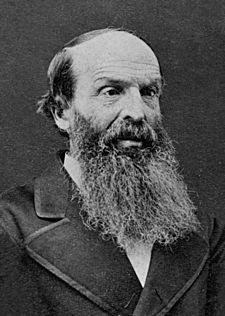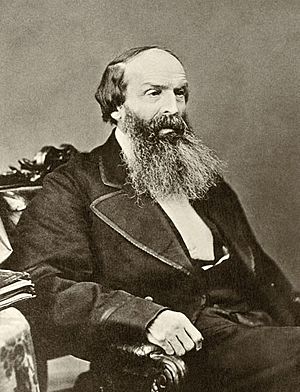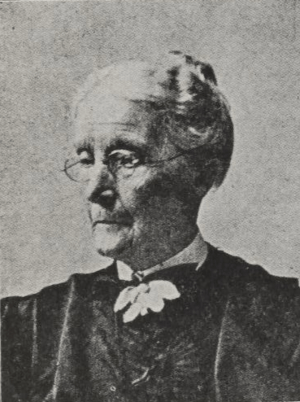Henry H. Spalding facts for kids
Quick facts for kids Henry H. Spalding |
|
 |
|
| Born | November 26, 1803 in Bath, New York, U.S. |
|---|---|
| Died | August 3, 1874 in Lapwai, Idaho, U.S. |
| Church | Presbyterian |
| Spouse | Eliza Hart (d. 1851) Rachel Jane Smith |
Henry Harmon Spalding (1803–1874) and his wife Eliza Hart Spalding (1807–1851) were important Presbyterian missionaries and teachers. They worked mainly with the Nez Perce people in the Pacific Northwest region of the United States.
The Spaldings and their friends were among the first Americans to travel across the western plains. They journeyed through the Rocky Mountains to reach their missions. These missions were in areas that are now the states of Idaho and Washington. Their group of five missionaries, including Marcus Whitman and his wife Narcissa, joined with fur traders. Together, they formed the first wagon train to travel the Oregon Trail.
Contents
Early Life and Education
Henry Spalding was born in Bath, New York, in 1803 or 1804. He studied at Western Reserve College. Later, he attended Lane Theological Seminary. In 1836, a group called the American Board of Commissioners for Foreign Missions (ABCFM) chose him to be a missionary. He was sent to work with the Nez Perce people in Idaho.
Eliza Hart was born on August 11, 1807, in Kensington, Connecticut. Her family moved to New York in 1820. She met Henry through a friend. They wrote letters to each other for about a year before meeting in person in 1831. Eliza was very keen on missionary work, just like Henry. They got married on October 13, 1833, in Hudson, New York.
Journey to the West
The Spaldings wanted to find a place to start a mission. The American Board first assigned them to the Osage people in Missouri. However, Henry met Marcus Whitman in December 1835. He convinced Marcus to go to the Oregon Country instead. After thinking and praying about it, Eliza agreed to this new plan.
In February 1836, they began their long journey. They traveled by steamboat from Pittsburgh to St. Louis. From there, they took another boat to Liberty, Missouri. In Liberty, they waited for a group of fur traders. The missionaries would travel with these traders as far as the Rocky Mountains.
On May 25, they joined the Rocky Mountain Fur Company caravan. This group was led by experienced mountain men named Milton Sublette and Thomas Fitzpatrick. The fur traders had seven wagons, each pulled by six mules. Eliza and Narcissa Whitman were the first Euro-American women to make this long trip overland.
In July 1836, while resting in the Wind River Mountains of Wyoming, Henry Spalding wrote a letter. This letter described their journey west. It is one of the earliest firsthand stories about traveling across North America.
Establishing Missions in the Pacific Northwest
After leaving the fur traders, the missionaries continued their journey to the Pacific Northwest. They reached Fort Hall on August 3 and Fort Boise on August 19. They arrived at Fort Walla Walla, run by the Hudson's Bay Company, eleven days later. After getting supplies from Fort Vancouver, they traveled back to Lapwai. This area is near what is now Lewiston, Idaho. The Spaldings finally settled into their new home on November 29, 1836. The Whitman family continued on to set up their mission in Waiilatpu, Washington.
When the Spaldings started their mission for the Nez Perce, they built the first home for white settlers in what is now Idaho. In 1839, they also brought the first printing press to the area. Henry Spalding was generally successful in working with the Nez Perce. He baptized some of their leaders and taught tribal members. He created a written alphabet for the Nez Perce language. He also translated parts of the Bible, including the entire book of Matthew, for his church members.
Eliza Spalding was very well-liked by the Nez Perce women. They often watched her to see how she cooked, cleaned, and cared for her children. They quickly respected her for her bravery. She also tried to help the Nez Perce and Henry get along, as Henry was not always as well-liked. He was very strict about gambling, alcohol, and having multiple wives. This sometimes led to him being criticized by some people. Henry was different from Eliza in how he related to the Nez Perce. Eliza tried to understand them, while Henry wanted them to understand him.
Henry also had some disagreements with his fellow missionaries. Because of criticism from Marcus Whitman and others, the American Board removed Henry from his position in 1842. However, he never left his mission or stopped his work. After a review, he was later given his position back.
The Whitman Massacre and Its Aftermath
On November 29, 1847, Marcus and Narcissa Whitman and twelve other people were killed at their mission in Waiilatpu, Washington. This event is known as the Whitman massacre. Some Cayuse people blamed the missionaries for bringing deadly diseases, like measles, which had caused many children in their tribe to die.
The Spaldings' daughter, Eliza, was staying at the Whitmans' mission school. She was safe, along with 45 other women and children. Young Eliza helped as a translator because she was the only survivor who knew the Nez Perce language. Two days later, Henry Spalding was on his way to the Whitmans' mission. He learned about the killings from Father John Baptist Brouillet, who had gone to help with the burials. Father Brouillet warned Spalding that he might also be in danger. Spalding got some supplies from the priest and went to Fort Walla Walla.
Spalding was able to reunite with his family at Lapwai. They had found safety with William Craig and the Nez Perce people. The Nez Perce kept the Spalding family safe as "hostages for peace." From there, Henry wrote to Bishop Francis Norbert Blanchet, asking him to help prevent any military attacks.
After a month of talks to free the massacre survivors, the Spalding family left. They were protected by some friendly Nez Perce. They traveled down the Columbia River to Oregon City, Oregon. The Spaldings stayed with Alvin T. Smith in what is now Forest Grove, Oregon. They lived there for a few months while the American Board was told about the situation.
Once safe, Henry Spalding was less interested in peace. His brother-in-law joined a group that wanted to punish those responsible. Spalding promised $500 from the American Board to help with their costs. Because of the ongoing violence between Native Americans and settlers, the American Board decided to close the mission permanently, even though Spalding did not want this.
Henry was upset when his letter to Bishop Blanchet became public. He blamed Blanchet. After thinking more about it, Spalding, who had strong feelings against Catholics, decided that they were behind the massacre. When a local newspaper refused to get involved in a religious argument, Spalding published his ideas in another newspaper. Father Brouillet, who had warned Spalding at great risk, felt that Spalding was very ungrateful. Brouillet's own story was printed in the New York Freeman's Journal.
The Spaldings built a small home in the area. Eliza became the first teacher at Tualatin Academy, which later became Pacific University. Henry served on the academy's board for many years. In May 1849, they moved to Brownsville, Oregon and started a farm. Henry served as a pastor for a church there. He was also the postmaster and a school commissioner for Oregon from 1850 to 1855. Eliza died on January 7, 1851. On May 15, 1853, Henry married Rachel Smith.
In his later years, Henry's work depended on funding from his church and his relationship with the U.S. Indian Affairs agent. To his great joy, he returned to the Nez Perce in September 1859 and to Lapwai in 1862. In the late 1860s, he was back in Brownsville. He blamed many of his problems in missionary work on the Catholic Church and the government. He felt so strongly about the government that in October 1870, he traveled across the country to Washington D.C. In March 1871, he spoke before the U.S. Senate. He did not return to the Northwest until September. In 1871, he started a government-supported Indian school. He also continued his missionary work with Native tribes in Idaho and Washington. He passed away in Lapwai, Idaho, on August 3, 1874.
The Spaldings had four children: Eliza Spalding Warren, Henry, Martha, and Amelia Spalding Brown. Eliza and Henry were the oldest. Eliza Hart Spalding was buried in Brownsville in 1851. More than sixty years later, her remains were moved to be buried next to her husband in Lapwai, Idaho.
The village of Spalding, Idaho, in Nez Perce County, was named after Henry Spalding. He taught the Nez Perce people many things, including how to use irrigation and grow potatoes.
Archival Collections
- The Presbyterian Historical Society in Philadelphia, Pennsylvania, has a collection of eight original letters from Henry and Eliza Spalding to their family members.
- The Spokane Public Library also has a large collection of letters, articles, and copies of documents about his life and missionary work.
- Whitman College in Walla Walla, Washington, has a large collection of materials related to the Spalding family.



